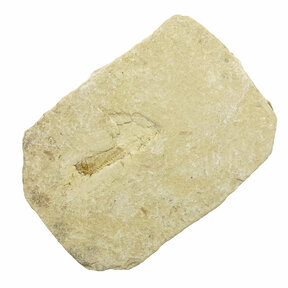Beautiful fossil fish found from various famous deposits in Brazil, Germany and the Green River formation in Wyoming Read more.
The Formation of Fossil Fish
The process of fossilization begins with the death of a fish, which then sinks to the seabed or lakebed. In an ideal situation, such as a calm bottom with minimal light exposure, low oxygen levels, and a soft muddy composition, the carcass remains relatively undisturbed. After several weeks, the decomposition process begins, but sudden geological activity, such as an earthquake, can mobilize sediment that quickly covers the carcass, a process often referred to as a rapid burial event. Once buried under sediment, the remaining flesh and soft tissues are broken down by bacteria, leaving only the skeleton behind.
Permineralization and Lithification
Over time, the skeleton is gradually buried deeper by accumulating sediment. The weight of the sediment slowly compresses the underlying layers, expelling excess water and depositing minerals in the pores, eventually turning the soft sediment into hard rock - a process known as lithification. During this process, the minerals in the water-saturated sediment replace the original minerals in the skeleton and fill any cavities formed by parts of the skeleton dissolving. This mineral replacement process is known as permineralization and results in a mineralized copy of the original skeleton.
The Discovery of Fossil Fish
After many millions of years, and after geological forces have lifted and exposed the rock to erosion, the fossil can finally be discovered. Careful extraction of the skeleton is required to prevent damage to the specimen. A generous amount of rock is retained around the specimen to protect it. Excavating fossil fish is a patient and precise task, but it reveals important information about past life and the evolutionary history of fish.
Solnhofen Fossils from Germany
The fish from Solnhofen, Germany lived in the late Jurassic, about 161-145 million years ago. They lived in a lagoon that was regularly cut off from the sea. The high salt content in both the water and sediment ensured that deceased animals were well preserved and fossilized. In the Altmühltal in Germany, there are several limestone quarries. In the middle of this area lies the village of Solnhofen, from which the limestone in the area takes its name. In reality, there are limestone quarries spread over tens of kilometers. The chance of finding fossils here is not even very high. However, regular finds come from the area due to the large-scale industrial extraction of limestone. This is mainly used for house construction, sculpture, or as decorative stone.
125 Million-Year-Old Brazilian Fish
The little fish from Brazil lived in the Cretaceous period and are about 125 million years old. They were found in the limestone quarries of Nova Olinda in Brazil. The quarries mainly produce laminated limestone, which yields thin plates used as tiles. The...
45-50 Million-Year-Old American Fish
The fish from the Eocene deposit of Green River, Wyoming, are between 45 and 50 million years old. During the Eocene, there was a vast lake teeming with life. Due to rainy and dry periods, a layer of sediment was added to the bottom of the lake each year. 6 million years of continuous sediment have been found. Between the sediment, small fish, and sometimes other animals such as shrimps, could be preserved. Due to the sedimentary seal, the carcass could not decompose and had the chance to fossilize. Wyoming is known for its wide variety of fossils and the high quality in which they are preserved.





